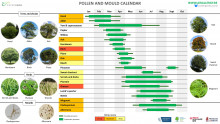In brief
The very first hazel pollen grains (Corylus) have been detected sporadically in the air in Brussels. This early occurrence can be explained by the premature flowering of a few well-exposed trees, encouraged by the mild temperatures observed since November.
At this stage, despite these limited local emissions, concentrations remain extremely low and do not allow the start of the pollen season to be considered. Regular monitoring across all stations in the network will resume at the beginning of January.









